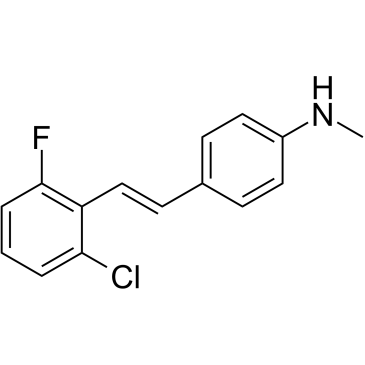
| 规格 | 价格 | 库存 | 数量 |
|---|---|---|---|
| 10 mM * 1 mL in DMSO |
|
||
| 1mg |
|
||
| 5mg |
|
||
| 10mg |
|
||
| 25mg |
|
||
| 50mg |
|
||
| 100mg |
|
||
| Other Sizes |
|
| 靶点 |
MAT2A (Methionine S-adenosyltransferase 2A) (IC50 = 2.1 μM)
|
|---|---|
| 体外研究 (In Vitro) |
FIDAS-5(3 μM;7 天)处理显着抑制 LS174T 细胞的生长 [1]。在 c-LS174T CRC 细胞中,FIDAS-5 (3 μM) 疗法可抑制 Myc 和细胞周期蛋白 D1。在 LS174T 细胞中用 FIDAS-5(3 μM;36 小时)处理可降低 S-腺苷甲硫氨酸 (SAM) 的表达和 S-腺苷高半胱氨酸诱导的 p21WAF1/CIP1 细胞周期 [1]。
|
| 体内研究 (In Vivo) |
FIDAS-5 治疗(20 mg/kg;口服强饲;每天;持续两周;无胸腺裸鼠)可显着减少异种移植肿瘤的生长,同时体重几乎没有变化[1]。将 FIDAS-5 (20 mg/kg) 给予小鼠一周。观察到肝脏 SAM 水平显着降低[1]。
|
| 酶活实验 |
亲和结合测定[1]
a) LS174T细胞裂解物为了纯化FIDAS靶标,将LS174T胞裂解物与链亲和素珠和生物素化的FIDAS-8在4°C下孵育过夜。将珠粒用细胞裂解缓冲液洗涤三次。结合蛋白用2.5mM D-生物素洗脱。纯化的样品通过4.12%梯度SDS-PAGE分离,并通过银染色或Sypro Ruby荧光染色进行分析。如前所述,切除FIDAS-8样品中特异性存在的蛋白带,并通过MALDI-TOF/TOF和LC-MS/MS进行分析 b) 将重组MAT2A、MAT2A和MAT2B克隆到pGEX-6P-3载体中。将构建体转染到大肠杆菌BL21中。GST融合蛋白通过IPTG诱导并通过谷胱甘肽珠纯化,如前所述。对于结合测定,将纯化的蛋白质与链亲和素珠和上述生物素化的FIDAS-8化合物一起孵育。用抗GST、MAT2A或MAT2B的抗体通过蛋白质印迹分析洗脱的蛋白质。他标记的MAT2A由pETDuet载体表达,用于SAM合成和诱变研究。根据生产说明使用HIS Select树脂纯化蛋白质,并使用补充有300mM咪唑的缓冲液洗脱 各向异性分析[1] 将FIDAS-3(2.5μM)与DMSO或MAT2A在96孔板中的100μL PBS缓冲液中混合。为了进行竞争测定,将SAM或L-甲硫氨酸加入到混合物中。使用SpectraMax M5在23°C下测量荧光各向异性,激发波长为358nm,发射波长为454nm,发射滤光片波长为420nm。样品在总体积为100μL的彩色96孔板中进行测量。[1] 孔雀绿磷酸盐(Pi)含量测定[1] 将L-蛋氨酸(1 mM)和ATP(1 mM)与纯化的His标记的MAT2A(5μg)在0.5 mL反应缓冲液(50 mM Tris pH8.0,50 mM KCl,10 mL MgCl2)中孵育30分钟。用SensoLyte MG磷酸盐测定试剂盒测量反应释放的无机磷酸盐。在酶标板读数器上在620nm处测量吸光度。对于抑制测定,将MAT2A与FIDAS试剂在室温下孵育20分钟,然后在0.5mL反应缓冲液中与L-甲硫氨酸和ATP混合。加入冷去离子水(2mL)以停止反应并稀释样品。 |
| 细胞实验 |
细胞活力测定 [1]
细胞类型: LS174T 结直肠癌 (CRC) 细胞 测试浓度: 3 μM 孵育时间: 7天 实验结果:显着抑制LS174T细胞的增殖。 (SAH)水平[1]。 |
| 动物实验 |
Animal/Disease Models: 16 athymic nude mice were injected with HT29 CRC cells [1].
Doses: 20 mg/kg. Route of Administration: po (oral gavage); kg). The liver SAM levels were Dramatically higher. Dramatically diminished [1]. Routine; two-week Experimental Results: Significant inhibition of xenograft tumor growth. |
| 参考文献 | |
| 其他信息 |
Methionine S-adenosyltransferase 2A (MAT2A) is the catalytic subunit for synthesis of S-adenosylmethionine (SAM), the principal methyl donor in many biological processes. MAT2A is up-regulated in many cancers, including liver cancer and colorectal cancer (CRC) and is a potentially important drug target. We developed a family of fluorinated N,N-dialkylaminostilbene agents, called FIDAS agents, that inhibit the proliferation of CRC cells in vitro and in vivo. Using a biotinylated FIDAS analogue, we identified the catalytic subunit of MAT2A as the direct and exclusive binding target of these FIDAS agents. MAT2B, an associated regulatory subunit of MAT2A, binds indirectly to FIDAS agents through its association with MAT2A. FIDAS agents inhibited MAT2A activity in SAM synthesis, and depletion of MAT2A by shRNAs inhibited CRC cell growth. A novel FIDAS agent delivered orally repressed CRC xenografts in athymic nude mice. These findings suggest that FIDAS analogues targeting MAT2A represent a family of novel and potentially useful agents for cancer treatment.[1]
In summary, researchers developed a novel family of stilbenes analogs, the FIDAS agents, by optimizing their anti-cancer activity. Our studies, as reported here, provide convincing evidence that the direct target of FIDAS analogs is MAT2A, specifically the catalytic subunit responsible for the synthesis of SAM. MAT2A levels are significantly increased in CRC and liver cancers, suggesting that MAT2A is a potentially interesting target for these cancers. We also analyzed the effects of FIDAS agents on other cancer cells, and found that these agents can inhibit the growth of multiple human cancer cell lines, including breast, prostate, lung, liver, carcinoid and head and neck cancer cells. Our finding that FIDAS agents affect SAM synthesis that in turn plays such a central role in numerous biological processes suggests an important mechanism that can be exploited for cancer treatment. The FIDAS agents, which uniquely block the activity of the catalytic subunit of MAT2A, are promising lead candidates and great experimental tools to study the role of MAT2A inhibition in cancer therapy. |
| 分子式 |
C15H13CLFN
|
|---|---|
| 分子量 |
261.721826314926
|
| 精确质量 |
261.07205
|
| CAS号 |
1391934-98-7
|
| PubChem CID |
57521314
|
| 外观&性状 |
Light yellow to yellow solid
|
| LogP |
4.9
|
| tPSA |
12Ų
|
| 氢键供体(HBD)数目 |
1
|
| 氢键受体(HBA)数目 |
2
|
| 可旋转键数目(RBC) |
3
|
| 重原子数目 |
18
|
| 分子复杂度/Complexity |
274
|
| 定义原子立体中心数目 |
0
|
| SMILES |
ClC1C=CC=C(C=1/C=C/C1C=CC(=CC=1)NC)F
|
| InChi Key |
KXVXICBOMOGFMH-JXMROGBWSA-N
|
| InChi Code |
InChI=1S/C15H13ClFN/c1-18-12-8-5-11(6-9-12)7-10-13-14(16)3-2-4-15(13)17/h2-10,18H,1H3/b10-7+
|
| 化学名 |
4-[(E)-2-(2-chloro-6-fluorophenyl)ethenyl]-N-methylaniline
|
| 别名 |
FIDAS-5; 1391934-98-7; (E)-4-(2-chloro-6-fluorostyryl)-N-methylaniline; 4-[(E)-2-(2-chloro-6-fluorophenyl)ethenyl]-N-methylaniline; 4-[(1E)-2-(2-chloro-6-fluorophenyl)ethenyl]-N-methylaniline; CHEMBL3314420; SCHEMBL11895362; SCHEMBL11895364;
|
| HS Tariff Code |
2934.99.9001
|
| 存储方式 |
Powder -20°C 3 years 4°C 2 years In solvent -80°C 6 months -20°C 1 month 注意: 该产品在溶液状态不稳定,请现配现用。 |
| 运输条件 |
Room temperature (This product is stable at ambient temperature for a few days during ordinary shipping and time spent in Customs)
|
| 溶解度 (体外实验) |
DMSO : ~125 mg/mL (~477.61 mM)
|
|---|---|
| 溶解度 (体内实验) |
配方 1 中的溶解度: ≥ 2.08 mg/mL (7.95 mM) (饱和度未知) in 10% DMSO + 40% PEG300 + 5% Tween80 + 45% Saline (这些助溶剂从左到右依次添加,逐一添加), 澄清溶液。
例如,若需制备1 mL的工作液,可将100 μL 20.8 mg/mL澄清DMSO储备液加入400 μL PEG300中,混匀;然后向上述溶液中加入50 μL Tween-80,混匀;加入450 μL生理盐水定容至1 mL。 *生理盐水的制备:将 0.9 g 氯化钠溶解在 100 mL ddH₂O中,得到澄清溶液。 配方 2 中的溶解度: ≥ 2.08 mg/mL (7.95 mM) (饱和度未知) in 10% DMSO + 90% (20% SBE-β-CD in Saline) (这些助溶剂从左到右依次添加,逐一添加), 澄清溶液。 例如,若需制备1 mL的工作液,可将 100 μL 20.8 mg/mL澄清DMSO储备液加入900 μL 20% SBE-β-CD生理盐水溶液中,混匀。 *20% SBE-β-CD 生理盐水溶液的制备(4°C,1 周):将 2 g SBE-β-CD 溶解于 10 mL 生理盐水中,得到澄清溶液。 请根据您的实验动物和给药方式选择适当的溶解配方/方案: 1、请先配制澄清的储备液(如:用DMSO配置50 或 100 mg/mL母液(储备液)); 2、取适量母液,按从左到右的顺序依次添加助溶剂,澄清后再加入下一助溶剂。以 下列配方为例说明 (注意此配方只用于说明,并不一定代表此产品 的实际溶解配方): 10% DMSO → 40% PEG300 → 5% Tween-80 → 45% ddH2O (或 saline); 假设最终工作液的体积为 1 mL, 浓度为5 mg/mL: 取 100 μL 50 mg/mL 的澄清 DMSO 储备液加到 400 μL PEG300 中,混合均匀/澄清;向上述体系中加入50 μL Tween-80,混合均匀/澄清;然后继续加入450 μL ddH2O (或 saline)定容至 1 mL; 3、溶剂前显示的百分比是指该溶剂在最终溶液/工作液中的体积所占比例; 4、 如产品在配制过程中出现沉淀/析出,可通过加热(≤50℃)或超声的方式助溶; 5、为保证最佳实验结果,工作液请现配现用! 6、如不确定怎么将母液配置成体内动物实验的工作液,请查看说明书或联系我们; 7、 以上所有助溶剂都可在 Invivochem.cn网站购买。 |
| 制备储备液 | 1 mg | 5 mg | 10 mg | |
| 1 mM | 3.8209 mL | 19.1044 mL | 38.2088 mL | |
| 5 mM | 0.7642 mL | 3.8209 mL | 7.6418 mL | |
| 10 mM | 0.3821 mL | 1.9104 mL | 3.8209 mL |
1、根据实验需要选择合适的溶剂配制储备液 (母液):对于大多数产品,InvivoChem推荐用DMSO配置母液 (比如:5、10、20mM或者10、20、50 mg/mL浓度),个别水溶性高的产品可直接溶于水。产品在DMSO 、水或其他溶剂中的具体溶解度详见上”溶解度 (体外)”部分;
2、如果您找不到您想要的溶解度信息,或者很难将产品溶解在溶液中,请联系我们;
3、建议使用下列计算器进行相关计算(摩尔浓度计算器、稀释计算器、分子量计算器、重组计算器等);
4、母液配好之后,将其分装到常规用量,并储存在-20°C或-80°C,尽量减少反复冻融循环。
计算结果:
工作液浓度: mg/mL;
DMSO母液配制方法: mg 药物溶于 μL DMSO溶液(母液浓度 mg/mL)。如该浓度超过该批次药物DMSO溶解度,请首先与我们联系。
体内配方配制方法:取 μL DMSO母液,加入 μL PEG300,混匀澄清后加入μL Tween 80,混匀澄清后加入 μL ddH2O,混匀澄清。
(1) 请确保溶液澄清之后,再加入下一种溶剂 (助溶剂) 。可利用涡旋、超声或水浴加热等方法助溶;
(2) 一定要按顺序加入溶剂 (助溶剂) 。